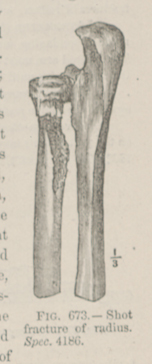Title: Lamareaux, A.
Source text: The Medical and Surgical History of the War of the Rebellion. (1861-65.), Part 2, Volume 2 (Washington, DC: Government Printing Office, 1876), 931.
Civil War Washington ID: med.d2e31325
TEI/XML: med.d2e31325.xml
CASE 1883.—Corporal A. Lamareaux, Co. E, 124th New York, aged 20 years, was wounded near Hatcher's Run, April 1, 1865, and admitted to the field hospital of the 3d division, Second Corps, where Surgeon O. Everts, 20th Indiana, recorded: "Gunshot wound of left arm." On April 5th, the man entered Douglas Hospital, Washington, whence Assistant Surgeon W. F. Norris, U. S. A., contributed the specimen (FIG. 673), together with the following description of the injury and operations which he performed: "Gunshot fracture of left radius. The ball was found to have entered the forearm from behind, fracturing the radius near its head, and lodging above the elbow joint in the arm. When admitted, the general condition of the patient was unfavorable, being feverish and without appetite; pulse 110. He stated that there was profuse hæmorrhage at the time of the injury. The parts were not healthy looking, the arm somewhat swollen and hot, and the hand œdematous. On April 6th the bullet was extracted, two counter-openings being made. On April 9th, secondary hæmorrhage occurred to the amount of six ounces, which ceased spontaneously. Another hæmorrhage occurred on the 13th, and two attacks took place on the 14th, the last two being very slight, The parts were still much swollen and painful, discharge profuse, tongue dry, and countenance pale. Patient has considerable pain in chest, and dyspnœa, but no cough, and is rapidly losing strength. On April 15th there was hæmorrhage, amounting to three ounces, at 8 A. M., which ceased upon slight compression of the brachial, but recurred at 12 M. to the amount of eight ounces, when the brachial artery was ligated in its continuity. The areolar tissue was found filled with clots of blood. The patient was almost moribund, and the operation was only a temporary measure, and was performed to render the patient comfortable, without expectation of saving life. He died of exhaustion, at 2 A. M. the following day, April 16, 1865. The autopsy, twelve hours after death, showed that the radius had been fractured just below the head, also that the radial artery had been severed by the bullet, and that the elbow joint had become secondarily involved. Incipient pneumonia existed in the posterior lobes of both lungs. The other organs were healthy. The specimen consists of the upper halves of the bones of the forearm."
